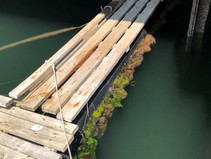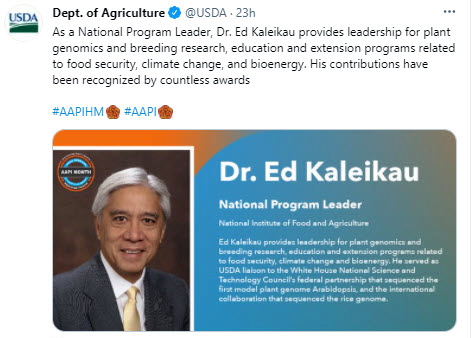 Every day, I am reminded of the strength of partnerships and the vital work we do together to help improve American lives, strengthen agriculture, protect our environment, grow local economies, and contribute to the body of science. Each of us has an integral role to play and a responsibility to our partnership. This week, we kicked off a pilot of a new program – LGU2U – to strengthen and renew essential partnerships between U.S. Land-grant Universities and NIFA. This new effort will not only help our new NIFA workforce learn more about our stakeholders and partners, but help us all enhance our mission, forge a clear path ahead and increase our capacity to build a better future. The pilot was led by LGUs' North Central Region leaders and NIFA liaisons. As the program is refined in the pilot, we expect to see it grow and expand to lead us to long-term partnership improvements. We look forward to the day when we also can expand this effort beyond the virtual world, and NIFA experts will be able to venture out and see firsthand your vibrant campuses and the impacts of the work we do together. Over the next few weeks, we will begin the migration of research reporting into the new integrated NIFA Reporting System. This has been a herculean effort by NIFA staff, with support from contractors, and our university partners. You have spent many hours at the table with us, sharing ideas, offering input, and giving guidance to make this effort successful. Be watching for more updates and information very soon. We appreciate your support and offer our continued commitment to strengthening and enhancing our partnerships in the months ahead. Thank you so much! Dr. Carrie Castille
Director, National Institute of Food and Agriculture |  USDA Announces New Initiative to Quantify Climate Benefits of Conservation Reserve Program USDA's Farm Service Agency (FSA) recently announced an initiative to quantify the climate benefits of Conservation Reserve Program (CRP) contracts. This multi-year effort will enable USDA to better target CRP toward climate outcomes and improve existing models and conservation planning tools while supporting USDA's goal of putting American agriculture and forestry at the center of climate-smart solutions to address climate change. "CRP is a powerful tool for implementing voluntary, measurable conservation outcomes to mitigate the impacts of climate change," said FSA Administrator Zach Ducheneaux. "Nearly 21 million acres currently enrolled in the program prevent the equivalent of more than 12 million tons of carbon dioxide from entering the atmosphere." For more information, read the FSA news release. Sunrise over a field of young corn, courtesy of Getty Images. |  Seeking Participants to USDA's Conservation Reserve Program USDA's Conservation Reserve Program (CRP) is making changes aimed at incentivizing more people to participate. USDA's Stephanie Ho talks with USDA's Farm Service Agency Administrator Zach Ducheneaux. The CRP program helps producers earn income and help the environment at the same time. For more information, listen to the USDA broadcast. |  NIFA Career Opportunities We are hiring! Remember to check out NIFA's Career Opportunities webpage, where there is a direct link to all open positions. You can also explore NIFA jobs at the USAjobs.gov website. Current openings in Kansas City, Missouri: Grants Management Specialist (GS 9-12)
Closing Date: 05/27/2021 Grants Management Specialist (GS 9-12)
Closing Date: 05/27/2021 |  Penn State Extension to Provide Vaccine Education to Underserved Communities Addressing COVID-19 vaccine hesitancy in Pennsylvania, with a particular focus on the Latino population and senior citizens ages 65 and older in rural communities, is the objective of a project spearheaded by Penn State University Extension. The Extension Collaborative on Immunization Teaching and Engagement — EXCITE— is a joint effort between the nation's Cooperative Extension System and the Centers for Disease Control and Prevention (CDC). The CDC recently provided nearly $10 million to USDA's National Institute of Food and Agriculture which, in turn, is channeling the funds to Land-grant Universities and the Cooperative Extension System for vaccine education. For more information, read the Penn State News article. Closeup of doctor giving a vaccine, courtesy of Getty Images. |  Extension Climate Change Action Forum Brings Leaders Together Utah State University (USU) Extension joined the Extension Foundation, USU's Western Rural Development Center and the University of California recently to host "Climate Change in Extension: Elevating and Amplifying Action." The virtual forum brought together Extension faculty, staff, federal representatives, administrators, and constituents to address the question of what the Cooperative Extension System should do to advance climate change programming. Over 200 participants engaged in dialogue with federal and state leaders each day, and the final day brought Extension professionals together to ideate action items for moving forward. "No idea or action is too small, but inaction is not an option," said National Institute of Food and Agriculture Director Dr. Carrie Castille. For more information, read the USU Today article. Utah valley, courtesy of Utah State University. |  Scientists Aim to Solve a Million Dollar Problem for Aquaculture Industry A pesky little jellyfish-like animal is causing major problems and major costs for aquaculture everywhere by choosing to permanently live on aquafarming equipment, reducing production sustainability. However, new research from the New Hampshire Agricultural Experiment Station in the University of New Hampshire (UNH) sheds light on possible ways to dissuade these animals at their early, larval stage. The research is vital to New Hampshire's oyster-dominated aquaculture industry, in which the number of farms grew faster than any other state, a 229 percent increase, from 2013 to 2018, according to the U.S. Census of Aquaculture. New Hampshire had nearly $1 million in sales from aquaculture in 2018. Globally, more than 50 percent of all human-consumed seafood is produced by aquaculture. This material is based on work supported by the NH Agricultural Experiment Station, through joint funding by USDA's National Institute of Food and Agriculture. For more information, read the UNH Today article. Aquaculture structures with ectopleura colonies on the sides. Image courtesy of UNH. |  Nanosensors for Food and Agriculture The National Nanotechnology Initiative (NNI) is hosting a webinar on June 2 from 1 to 2:15 p.m. ET, to discuss nanotechnology-enabled sensors (nanosensors). A promising tool to advance precision agriculture and support a safe and robust food supply chain, from farm to fork. Panelists will share their vision for how the development and deployment of nanosensors could transform agriculture and food safety. Go online to register or learn more about the NNI webinar. Webinar graphic, courtesy of Adobe Stock. | NIFA Invests $7.2 Million in Inter-disciplinary Animal Research NIFA recently awarded eight Inter-Disciplinary Engagement in Animal Systems (IDEAS) grants. This program priority area seeks to bridge traditional disciplinary divides and address complex issues in animal agriculture, with special attention to precision animal management, environmental synergies of animal production, and societal aspects of animal welfare. This research and associated extension will enhance rural prosperity by tackling the complexity of social, cultural, environmental, economic, and technologic challenges facing the food and agriculture system in the United States today. These grants are part of NIFA's Agriculture and Food Research Initiative. USDA SBIR Program awards $811K in Rural and Community Development Grants to Small Businesses The USDA Small Business Innovation Research (SBIR) Program, which is administered by NIFA recently awarded eight grants to US small business to improve the quality of life in rural America. These projects will create and commercialize new and existing technology, products, processes, and services that will: - Enhance efficiency and equity of public and private investments
- Build a diversified workforce
- Increase resilience to natural and human disasters; and
- Improve economic vitality of rural communities and the reduction of poverty
NIFA SBIR Program awards $611K to Help Small Businesses Ensure Healthy and Productive Forest Ecosystems NFA recently awarded six grants under the Forest and Related Resources topic area of the USDA's Small Business Innovation Research (SBIR) program. SBIR is a highly competitive program that encourages domestic small businesses to engage in Federal Research/Research and Development (R/R&D) that has the potential for commercialization, including qualified small businesses in the nation's R&D arena that stimulate high-tech innovation. SBIR strengthens the United States entrepreneurial spirit as it gains specific research and development needs. These early stage innovation grants focus on protecting the nation's forested lands and resources to help ensure the continued existence of healthy and productive forest ecosystems. NIFA Invests Over $606K for Aquaculture Research NIFA recently awarded six Aquaculture Research Program grants for research to support the development of new science-based information and technology for environmentally and economically sustainable aquaculture industry in the United States. The Aquaculture Research Program is authorized by the Competitive Special and Facilities Research Grants Act to develop practical solutions that will facilitate growth of the U.S. aquaculture industry, reduce the U.S. trade deficit in seafood products, and enhancing the capacity of the U.S aquaculture industry to contribute to food security and economic growth.  |

No comments:
Post a Comment